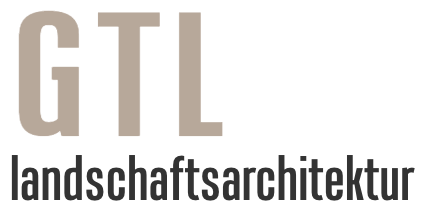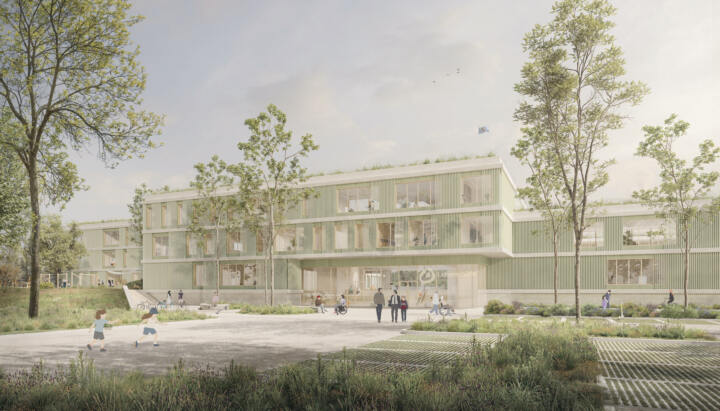1st Prize | New construction of the Special Education Centre
Senden Neu-Ulm
In collaboration with Atelier30
Urban integration and landscape interlocking
The new building of the curative education centre in Senden presents itself as a finely tuned ensemble of three staggered structures that blend sensitively and naturally into the topography of the site. Together with the integrated sports hall and therapy area, the result is an architecturally and functionally multi-layered integration with the urban environment and the surrounding landscape. The differentiated structure and staggered heights of the buildings convey a sense of scale and allow for harmonious integration into the terrain from every perspective.
The main address of the centre faces south-east, where a generously designed forecourt with a clearly defined main entrance creates an inviting, representative entrance. From here, the communicative centre of the facility opens up, connecting all the main areas as its heart.
In the north-west, the outdoor play areas – including an all-weather pitch, a grass playing field and a school garden – form the scenic conclusion and underline the close connection between built space and open space.
Topographical integration and spatial diversity
The arrangement of the buildings follows the natural slope of the terrain and translates it into a structurally and functionally richly differentiated building landscape. The idea of interlocking continues inside: bright, spacious corridors, open lounge areas and diverse visual connections to the outside create an inspiring, light-flooded learning and working atmosphere. The clear structure of the buildings supports intuitive orientation and enhances the spatial quality.
Access and functional organisation
The central main entrance leads into a light-flooded foyer and break hall, which serves as the spatial heart of the building. The café and music rooms are directly connected here and can be flexibly opened up to the hall. The internal access is clearly structured and the routing is intuitive.
From the centre, the sports and therapy area with swimming pool and the children’s house are accessed on the ground floor. All functional areas are separately accessible if required and clearly separated from each other in terms of function. The central break hall connects all the main areas of the building via a spacious atrium. Social and recreation rooms are grouped around a gallery on the upper floor, supplemented by the primary and vocational school levels. The second floor houses the administration, the staff rooms and the secondary school, each of which can be identified as separate areas.
As in the rest of the building, recesses in the corridor areas create varied communication spaces with views of the outdoors and green inner courtyards. The open-plan concept supports a pleasant learning atmosphere and at the same time allows for a high degree of flexibility: the modular floor plan structure allows for future adjustments to the room layout.
A high proportion of green roof and façade areas not only improves the microclimate, but also functions as a retention area for rainwater. The basement houses technical and ancillary rooms as well as 28 parking spaces.
Arrival
The new school day begins on the forecourt at the junction between the existing building and the new special education centre. Overshadowed by a group of multi-stemmed, generously underplanted sweetgum trees with benches floating around them, the entrance plaza serves as both a passageway and a lounge area. Here, somewhat shielded behind the group of trees, are the bicycle parking spaces located near the entrance.
School landscape
We see the open space directly adjacent to the break hall as a school landscape that meets the space requirements of the room programme and is as green as possible. It is partially covered by large-crowned trees of the future and structured by lowered grass and shrub areas under the tree crowns, which, in addition to their insect-friendly abundance of flowers, also serve as retention and drainage areas. The central playground is paved with permeable concrete paving stones with partially linear lawn joints. The green classroom in the south-east, partially enclosed by low planting and directly adjacent to the school garden, offers space for outdoor learning away from the hustle and bustle of the playground. A mixed hedge of bird-friendly shrubs forms the boundary and transition to the agricultural landscape in the south. Where there is no need for playable and accessible lawns, sparse, two-cut meadows contribute to biodiversity. The southern area of the schoolyard is designed as an exercise landscape with a small playing field, a climbing wall and other exercise facilities.
Protected open space for the children’s house
The outdoor area of the children’s house is designed as a gently modelled play and adventure world, which, in addition to age-appropriate play equipment and sufficient paved areas, leaves room for nature-oriented play in the peripheral areas. Deciduous trees with rather sparse crowns ensure a pleasant climate all year round – plenty of sun when the trees are bare, sufficient shade in summer.
The edges of the peripheral areas are planted with edible and useful plants such as strawberries and blueberries, mint and lemon balm, as well as hazelnut bushes, which are robust enough for intensive use and also vividly integrate the seasonal changes into the educational concept.
Water management and biodiversity
In addition to meeting the requirements of the exercise, learning and play landscape, the outdoor facilities also fulfil the basic functions of a resilient and sustainable built environment. These include a maximum of structurally rich vegetation areas, water-permeable surface pavements and a rainwater management system as a recirculation system. The roof surfaces of the school building are designed as retention roofs. (18 cm substrate on the roofs (even with possible solar use), with retention boxes with a capillary wick system for optimal precipitation retention and evaporation). The substrate layer, in conjunction with the retention boxes, stores rainwater and makes it available to the plants. In the earth-bound vegetation areas, the rainwater is fed to the planting areas or tree trenches through the formation of the topography and is also collected in cisterns for service water use.
In addition to aesthetic considerations, all plantings are designed to make a valuable contribution to biodiversity. A targeted selection of different substrates in the peripheral areas creates a mosaic of ecologically valuable sites, which develops into particularly species-rich plant communities through the sowing of native wild herb seeds.



